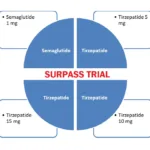Trulicity is the brand name of Dulaglutide, a once-weekly administered anti-diabetic medicine. It is one of the novel antidiabetic medicines that has the added benefit of weight loss.
Trulicity MOA (Mechanism of action of Dulaglutide) as an antidiabetic drug, how it causes weight loss, its cardiac effects, and other side effects, especially pancreatitis, are discussed here one by one.
What is Trulicity (Dulaglutide)?
Trulicity or Dulaglutide is a GLP-1 analog. It is the third among the GLP-1 analogs that have been approved for the treatment of patients with T2DM.
Being a GLP-1 analog, it has incretin-like effects since it activates the endogenous incretin receptors.
It is available as 0.75 mg and 1.50 mg once-weekly disposable injections. Trulicity is more effective than exenatide (Byetta) in clinical head-to-head comparison trials.
At 26 weeks of its use, dulaglutide (Trulicity) lowered the glycated hemoglobin by 1.3% and 1.5% when administered at doses of 0.75 mg and 1.5 mg once weekly [Ref].
Trulicity offers the advantage of once-weekly administration at the cost of a needle-prick fear.
It can be combined with metformin, SGLT-2 inhibitors (empagliflozin, dapagliflozin, ertugliflozin), pioglitazone, sulfonylurea (Gliclazide, Glimepiride), or insulin.
However, it is not recommended in combination with other GLP-1 analogs like Semaglutide and liraglutide and DPP-IV inhibitors like Sitagliptin, Vildagliptin, Saxagliptin, or Linagliptin.
Trulicity MOA as an antidiabetic drug – How does it lower blood glucose?
Trulicity lowers blood glucose by the following mechanisms:
Glucagon-like peptide (GLP) and Gastric inhibitory peptide (GIP) are the two important incretin hormones. Trulicity (Dulaglutide) is a GLP-1 analog, unlike Tirzepatide (Mounjaro), which is a dual GLP/GIP analog.
Trulicity acts on incretin receptors and causes the release of insulin in a glucose-dependent manner.
When the plasma glucose levels are elevated, the release of insulin from the beta-cells of the pancreas is stimulated, and insulin is released.
Trulicity or Dulaglutide also inhibits the release of glucagon when the plasma glucose levels are high.
When glucagon release is inhibited, glucose production by the liver cells is inhibited. Simultaneously, glycogen breakdown is also inhibited, which can increase blood glucose.
Dulaglutide or Trulicity inhibits gastric motility. This causes a slow release of gastric contents into the intestine to be absorbed. Hence, Trulicity improves the post-meal rise in blood glucose.
Trulicity improves Beta-Cell function and reduces insulin resistance. The effect on insulin resistance is lower compared to metformin [Ref].
Trulicity MOA as a Weight Loss Drug?
All GLP-1 analogs have been associated with weight loss in diabetic patients. The degree of weight loss among the different GLP-1 analogs is variable.
For example:
- Semaglutide administered orally resulted in a weight loss of about 8.4 pounds after 26 weeks in the Pioneer 2 Trial.
- Ozempic (injectable Semaglutide) administered in a dose of 0.5 mg and 1 mg once weekly resulted in a weight loss of 9.2 and 12.1 pounds, respectively [Ref].
GLP-1 anlaog: Semaglutide | Weight Loss |
| Rybelsus (Oral Semaglutide) | 8.4 lbs after 26 weeks |
| Ozempic 0.5 mg | 9.2 lbs after 26 weeks |
| Ozempic 1 mg | 12.1 lbs after 26 weeks |
- Liraglutide (Saxenda, Victoza) is the only GLP-1 analog that has been approved for weight loss. The recommended dose for weight loss is 3 mg subcutaneously once a day.
- Liraglutide was found to cause a weight loss of about 15 pounds (6.8 kgs) after 8 weeks of treatment. When combined with a low-calorie diet and exercise, it resulted in a weight loss of 21 pounds (9.5 kgs) [Ref].
GLP-1 anlaog: Liraglutide | Weight Loss |
| Liraglutide (Saxenda) 3 mg | 15 lbs (6.8 kgs) after 8 weeks |
| Saxenda + low-calorie diet | 21 lbs (9.5 kgs) after 8 weeks |
- Dulaglutide was found to cause weight loss ranging from 2.8 to 4.1 kg. The effect on weight loss was dose-dependent. A greater weight loss was noted when the drug was used at supratherapeutic doses [Ref].
Although not very clear, Dulaglutide causes weight loss by the following mechanisms:
It causes the release of insulin in a glucose-dependent mechanism. Thus, its effects on insulin secretion are modest.
It inhibits gastric motility, resulting in early satiety, nausea, vomiting, and post-meal fullness. Patients do not feel like eating when being treated with dulaglutide. Thus, less food and fewer calories are taken.
It inhibits the absorption of food and hence has a direct weight-losing effect.
The slow release of gastric contents into the intestine causes a blunting of the glucose spike in the plasma. This, in turn, results in less insulin release and hence less weight gain (Since Insulin is an anabolic hormone).
Why may Dulaglutide increase the risk of pancreatitis?
Gastrointestinal and hepatobiliary side effects are among the most common side effects of all GLP-1 analogs. Pancreatitis, in particular, has been specifically associated with GLP-1 analogs.
Cases of acute pancreatitis, acute necrotizing pancreatitis, and chronic pancreatitis have all been reported with GLP-1 analogs.
A recent meta-analysis of randomized clinical trials did not find any association between GLP-1 receptor agonists and pancreatitis [Ref].
The mechanism of pancreatitis resulting from GLP-1 analogs is not fully understood. It is thought to cause direct pancreatic cell toxicity.
GLP-1 analogs have also been thought to cause an elevation of pro-inflammatory cytokines that may result in pancreatitis.
In human autopsy studies and animal studies, both of these thoughts have been negated.
In Conclusion:
Trulicity MOA: Trulicity (Dulaglutide) acts primarily via the incretin receptors, causing the release of insulin and inhibition of glucagon in a glucose-dependent mechanism.
It also inhibits gastric motility and reduces appetite, which could result in weight loss.





